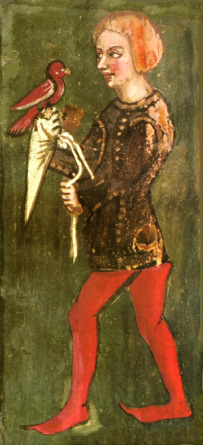...Best of Sicily presents... Best of Sicily Magazine. ... Dedicated to Sicilian art, culture, history, people, places and all things Sicilian. |
by Luigi Mendola | |||
Magazine Index Best of Sicily Arts & Culture Fashion Food & Wine History & Society About Us Travel Faqs Contact Map of Sicily
|
The Steri epitomises the style known as "Chiaramonte Gothic," in which the castles of Mussomeli, Naro and Malta - specifically the old part of the knights' Fort Sant'Angelo in Valletta - were built. These palatial fortresses were all erected in what were then fiefs of the Chiaramonte family, and while the family cannot be credited with inventing this style (sometimes called "Romanesque Gothic"), they did much to perpetuate it in Sicily. The beautiful stonework of the Steri's interiors is visible today only as the result of a series of extensive restorations during the twentieth century; the walls of the courtyard and other areas were covered in stucco for several centuries. King Martin lay siege to the Steri in 1392 and following his victory beheaded Andrew Chiaramonte in front of his own castle, thus sending a message to potential rebels. As the month-long battle included a naval assault, it is important to have physical idea of the environs in those times, because the Steri today is some distance inland. When it was built, the Steri was almost on the water, with the shore reaching slightly farther inward from Via Butera to within a hundred metres of the castle, while the Cala lie where it is today, with Castello al Mare (Castle by the Sea) actually on the coast. The sea wall (including the Mura della Cattive) was constructed in the sixteenth century as a bulwark against the raids of Barbary pirates. The grassy park now bordering the shore on the opposite side of the coastal road (now Via Crispi, the Foro Italico and Via Messina Marine) beyond that wall was built of rubble (from Piazza Magione and other bombed areas) following the Second World War. The Steri complex also includes the chapel of Saint Anthony next to the castle. The immediate area (bordering the Kalsa district) was part of the most important part of Arab Palermo, or Bal'harm. It is thought that Via Alloro nearby was the main street of the Khalesa quarter, and in a number of palaces in the narrow streets between Piazza Marina and the Spasimo can be seen traces of thirteenth-century arches and windows similar to those of the Steri and various churches. When the Steri was built, the basilicas of the Magione (12th century) and Saint Francis of Assisi (13th century) were already standing, and so was the Castle by the Sea. Palazzo Abatellis and the churches of the Catena (just a few steps away) and Saint Mary (near what is now Piazza San Domenico) followed in the last decade of the fifteenth century. In Punic times this area was under water, as the Cala bay was farther inland, reaching a point near what is now the intersection of Via Roma and Via Vittorio Emanuele a few blocks away. The fortress was not built in architectural isolation. Its ornate, arched two-light windows recall those of similar structures, particularly in Italy, France and Spain. The highlight of the Steri is the Great Hall or "Barons' Hall," with its decorated wooden ceiling featuring biblical, mythological and historic scenes, all depicted in an imagery and style typical of the period, including the occasional coat of arms. It is somewhat similar to the contemporary ceilings of Saint Agueda Chapel in Barcelona and Santo Domingo de Silos (also in Spain), though perhaps influenced to some degree by the Arab ceiling of Palermo's Palatine Chapel painted almost two centuries earlier. A few other Sicilian aristocratic residences in Sicily boast this kind of decoration (though in these other structures it is only partially preserved), most notably Carini Castle.
The Steri, of course, represents much more than a view through the centuries. It was literally the cornerstone of royal power in Sicily, and therefore the central Mediterranean, for several centuries when most of the island's monarchs lived far away, in Aragon and then in Madrid, as many were also the kings of Spain. It is easy to imagine important aspects of the sixteenth century campaigns in Lepanto and Tunisia being planned here. Until almost 1600, when a king or (more often) a viceroy called a meeting of barons, it was usually at the Steri. Indeed, a street now called Via Parlamento recalls a route the barons took to arrive at the imposing Steri, which stood out as the highest building in this part of Palermo. For a few centuries, the city was the victor in its longstanding rivalry with Messina and then Catania. More than the Norman Palace, which remained important for administration, the Chiaramonte's stronghold could protect the viceroys from any insurrection. The strategy was not entirely valorous, considering that Castello al Mare and the Cala were close enough to facilitate a ready escape from Palermo in the event of a "popular" uprising against an unpopular viceroy. The Steri is open by appointment. It is usually possible to visit the courtyard. The Palazzo Abatellis Gallery, which houses a fine collection, is in Via Alloro nearby. About the Author: One of Sicily's foremost historians, Luigi Mendola is the author of two books. | ||
Top of Page |
 Constructed beginning in
the last years of the thirteenth century, and essentially completed by 1320,
the Steri was the principal castle of the infamous
Constructed beginning in
the last years of the thirteenth century, and essentially completed by 1320,
the Steri was the principal castle of the infamous  To a certain extent the Steri's paintings, and in some ways perhaps
the castle itself, represent an important part of the "
To a certain extent the Steri's paintings, and in some ways perhaps
the castle itself, represent an important part of the "